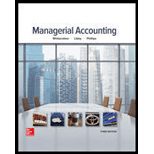
Concept explainers
Define each of the following terms variable cost, fixed cost, step cost, and mixed cost. Give an example of each.
Concept introduction:
There are three types of costs according to the unit of production; Variable, Fixed and Mixed. Variable costs change proportionally with the number of units produced and variable cost per unit remains constant. Fixed Cost remains same in totality irrespective of the number of units produced.
The mixed cost is the mix of variable and fixed cost, some of its part is fixed and some variable.
To discuss:
The meaning of each type of costs
Answer to Problem 1Q
The meaning of each type of costs is as follows:
- Variable costs: Variable costs change with the level of activity.
- Fixed Costs: Fixed costs remain same irrespective of the level of activity.
- Step Costs: Step Costs remain same up to a level and change after that.
- Mixed Costs: The mixed cost is the mix of variable and fixed cost, some of its part is fixed and some variable.
Explanation of Solution
There are three types of costs according to the unit of production; Variable, Fixed and Mixed. Variable costs change proportionally with the number of units produced and variable cost per unit remains constant. Fixed Cost remains same in totality irrespective of the number of units produced. The mixed cost is the mix of variable and fixed cost, some of its part is fixed and some variable.
The meaning of each type of costs is as follows:
- Variable costs: Variable costs change with the level of activity.
- Fixed Costs: Fixed costs remain same irrespective of the level of activity.
- Step Costs: Step Costs remain same up to a level and change after that.
- Mixed Costs: The mixed cost is the mix of variable and fixed cost, some of its part is fixed and some variable.
Want to see more full solutions like this?
Chapter 5 Solutions
Managerial Accounting
- 4 POINTSarrow_forwardWhat was its total assets turnover ratio on these financial accounting question?arrow_forwardNicole Manufacturing had 780 units in beginning work in process on September 1, 2023. During the month, an additional 2,600 units were started in production. At the end of September, 1,150 units remained in work in process. How many units were completed during September? Helparrow_forward
- During the current year, a business sells equipment for $440,000. The equipment cost $290,000 when purchased and placed in service two years ago and $85,000 of depreciation deductions were allowed. The results of the sale are ____. OPTIONS: A) ordinary income of $120,000. B) Sec. 1231 gain of $120,000. C) ordinary income of $90,000 and LTCL of $30,000. D) ordinary income of $85,000 and Sec. 1231 gain of $150,000.arrow_forwardDuring the current year, a business sells equipment for $440,000. The equipment cost $290,000 when purchased and placed in service two years ago and $85,000 of depreciation deductions were allowed. The results of the sale are ____. OPTIONS: A) ordinary income of $120,000. B) Sec. 1231 gain of $120,000. C) ordinary income of $90,000 and LTCL of $30,000. D) ordinary income of $85,000 and Sec. 1231 gain of $150,000.solve thisarrow_forwardMadison Industries uses the FIFO (first-in, first-out) method in its process costing system. The mixing department had $4,800 in material cost in its beginning work in process inventory, and $68,000 in material cost was added during the period. The equivalent units of production for materials during the period were 17,000 units. What is the cost per equivalent unit for materials?arrow_forward
- At the end of the year, the company has Assets of $180,000 and Liabilities of $140,000. At the beginning of the year, the company had Owners' Equity of $60,000. How much did Owners' Equity change by the end of the year? Did Owners' Equity increase or decrease? HELParrow_forwardOn January 1, 2020, Acme Corporation leased equipment to Zenith Company. The lease term is 10 years. The first payment of $850,000 was made on January 1, 2020. The equipment cost Acme Corporation $6,250,000. The present value of the minimum lease payments is $7,150,000. The lease is appropriately classified as a sales-type lease. Assuming the interest rate for this lease is 8%, how much interest revenue will Acme record in 2021 on this lease? a. $500,000 b. $504,000 c. $572,000 d. $624,000arrow_forwardHow many units were completedarrow_forward
- Principles of Accounting Volume 2AccountingISBN:9781947172609Author:OpenStaxPublisher:OpenStax College
 EBK CONTEMPORARY FINANCIAL MANAGEMENTFinanceISBN:9781337514835Author:MOYERPublisher:CENGAGE LEARNING - CONSIGNMENT
EBK CONTEMPORARY FINANCIAL MANAGEMENTFinanceISBN:9781337514835Author:MOYERPublisher:CENGAGE LEARNING - CONSIGNMENT

